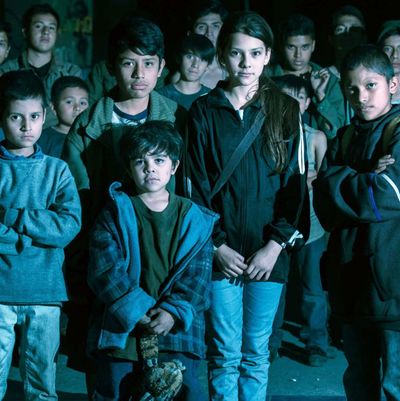
“I like a movie that starts bleak, gets bleaker, and then ends in hell,” writer and director Issa López tells Vulture. The proclivity might surprise her fans, especially those in Mexico. For most of her career, she’s been known for comedies like Casi Divas, Niñas mal, and Ladies’ Night. But for the past two years, she’s been touring a dark fairy tale, Tigers Are Not Afraid, through festivals and premieres around the world. It has garnered praise from horror giants like Stephen King and Guillermo del Toro, and finally made its theatrical debut in the United States last weekend.
Despite her background in comedy, López’s favorite films are the ones that dive into the darkness. She says she fell into genre cinema as a way to cope with the traumas of her own childhood, which included being orphaned at the age of 8 after the death of her mother. López was heartbroken, of course, but remembers laughing and going out to play just hours after hearing the news. “I felt horrible,” says López. “But that’s who you are as a kid. That’s how you survive: through fantasy, through creating stories, through playing. That’s what the movie’s about.”
Tigers follows a group of orphaned kids pitted against a violent gang, with only their imaginations and their found family to protect them. To achieve the right balance of fantasy, horror, wonder, bleakness, and joy, López knew she needed to thread a lot of story elements together at the outset. That’s why, she says, the film’s opening sequence was the most difficult to construct. In a cluster of scenes that cut between night and day in an alley and a classroom, López introduces her two young protagonists and establishes both the violence and magical realism that define the world around them. Before her film’s long-awaited Stateside debut, the director spoke with Vulture about how, through many revisions and a very happy accident, she crafted just the right beginning for Tigers Are Not Afraid.
Setting the Rules of the World
The filmmaker sees the orphan characters as Lost Boys — Shine (Juan Ramón López) serves as a Peter Pan and Estrella (Paola Lara) a Wendy — all united by shared loss in a Neverland perpetually under threat by a local gang, the Huascas. We meet Shine in the dark of night, as he is tagging a wall with his signature cartoon tiger. Then the camera cuts to Estrella, who is writing a short story in her classroom in the light of day. When gunfire outside the school disrupts her “universe of order,” as López says, forcing her to dive down and take cover, the teacher comforts Estrella by handing her three broken pieces of chalk and says they will grant her three wishes. Meanwhile, the camera moves back to Shine, already on his own, robbing and attempting to shoot one of the Huascas before freezing up and running away.
These scenes were shot linearly (the kids were not told the ending in advance so the story was a surprise), but it wasn’t until the director got in the editing room that she realized how to stitch her heroes’ sagas together. “The script changed a lot until we nailed it,” says López, “and honestly it kept changing in the editing room where eventually I went, ‘Okay, three wishes. That comes from fairy tales, and I have more elements. I have a tiger and these kids that are trying to be warriors,’ and I realized that I had been writing a fairy tale from the very beginning.”
That’s when López decided Estrella needed to be writing a fairytale of her own, so she wrote the crucial voice-over we hear — a narrated tale of warriors and princes — and had Lara record it for the scene. The chalk from the teacher turned from a surface distraction into a key plot element, which set up the rest of the movie’s dreamlike undertones. It also tied the beginning of the story to the finale. “It binds the movie together,” says the director.
Add the Magic
“The entire tone of the movie is supposed to be the clash but coexistence of extreme realism with fantastical elements,” López says. “It’s made to look and feel like a war documentary, but there’s a trickle of blood that follows you around the world, or a plush tiger that walks behind you, or a dragon that flies out of her phone and comes back into it. All of that has to coexist in this extremely real universe.”
So when Estrella finally leaves her classroom — and finds a dead body in the street on the way home — the idea of her three wishes isn’t anything more than a creative coping mechanism for children. “I needed an element that was going to tell you from the start, this is going to be magical, this is going to be supernatural,” López explains. “I think you can pull any trick from your hat as long as you show at the very beginning what are the elements of the trick you’re going to do.”
López had written a trickle of blood flowing from the corpse into an early draft of the script, but hadn’t fleshed out its purpose. And so, in the process of revising her script, the blood became a relentless spirit presence that follows Estrella until it stations itself on a dress that belonged to her mom, ominously staining it red. “She sees a dead body, turns around, and walks away, but you don’t walk away from the dead in Mexican culture, because it will not let you look away. It will come behind you,” López says.
The director calls the emergent blood trail, which follows Estrella for the rest of Tigers, “the micro-moment” that encapsulates her film.
The Accidental Tiger
Despite its presence in the title of López’s film, the tiger, which serves as a totem for Shine’s gang and is spray-painted onto surfaces throughout the movie, did not come to the writer-director until right before she started filming. And it happened on accident.
López wanted Shine to encounter something as he was creating his graffiti drawings in the street — a nod to the wild, or what would happen if man were to disappear. “This was one of the later scripts,” López explains. “I keep on rewriting and reimagining as the visuals start to fall in place. So, I went to my producers and I said, ‘I’m going to be needing a zebra now.’”Animals of the Serengeti are obviously not native to Mexico, but López says some drug lords are known to keep their own personal zoos. It turned out they couldn’t ethically source a zebra through an approved animal handler, so instead, producers offered her a hippo as a replacement. For obvious comedic reasons, the hippo was a no-go, so López declined that offer and eventually they came to her with the option of a tiger.
That’s when the director realized that the tiger could also serve as a binding metaphor in her narrative, something savage and beautiful that does not belong in this ravaged city but still has the strength to conquer it anyway. Just like her orphans. “The thing is, you cannot put in a tiger and then never speak about it, because it’s a Checkov’s gun,” López tells Vulture. “It’s a wild creature. It’s a threat. It’s also a very powerful symbol. So, I loved the image and I realized that if I was going to put the tiger in the movie it needed to become quite central to it.”
Once she had her new totem in place, she rewrote the script to specifically note that Shine would be tagging the Mexican landscape with a tiger, a mascot for his Lost Boys and Estrella. “The tiger is a symbol of power. It’s a creature that was lost and went through hell, and when Shine speaks about the tiger, he’s talking about himself and how he rules the city and does whatever he wants,” says López “But he’s not quite a tiger yet, and that’s the journey of the character.”


